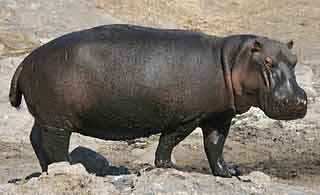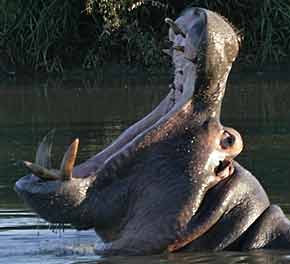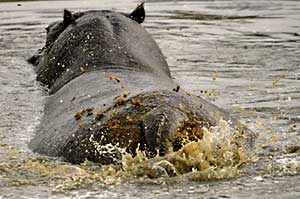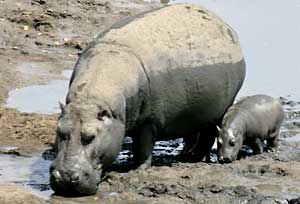Contact Details: Scotch Macaskill, Dirt Road Traders, Currys Post Road, Howick, KwaZulu-Natal, South Africa. Tel: +27 (0)82 578 2329. Privacy: Your privacy is guaranteed. See our Privacy Policy for more. This site accepts advertising and other forms of compensation - see Disclosure and Advertising for details. Site updated: 2022. Copyright © 2002 - 2022 Scotch Macaskill

| ||||||||||
|
||||||||||
|
See also info about: |
Hippo Information
Appearance:
Hippos don't have fur on their coats, instead the skin is smooth and hairless. It's mainly a grayish-black colour, with pink tinges at the skin folds, and around the eyes, ears, and underparts. The tail is short and flattened with a small tuft of black hair at the tip. The hippo's mouth is made up of huge tusk-like canines and incisors. Behavior:
Hippos usually occur in groups or "pods" of 10 to 15 animals, but larger groups do occur and solitary bulls are not uncommon. Dominant bulls mark their territory by spraying dung. Hippos can sometimes be seen opening their mouths wide, as if yawning, but are in fact showing off their formidable canines to impress and intimidate competitors or intruders (see our blog post, Hippo in Yawning Display, for more). An adult hippo can stay under water for up to six minutes. If provoked, startled or cornered, the hippo can be extremely dangerous. Hippos have a reputation for killing more people in Africa than any other wild animal, although this is debatable. (See Hippos - is their Bad Reputation Deserved? for more on this).
Reproduction:
The hippo mother leaves the other hippos in the pod when it's time to give birth, and then keeps her newborn calf hidden in the reeds. At this point the mother is very aggressive and unpredictable, and inclined to attack if she is disturbed.
Diet:
Sounds:
For additional information about the hippopotamus, see our gallery of Hippo Pictures. Return to Wildlife Info |
|||||||||
|
|
||||||||||

 Hippo opening its huge jaws in "yawning" display
Hippo opening its huge jaws in "yawning" display

